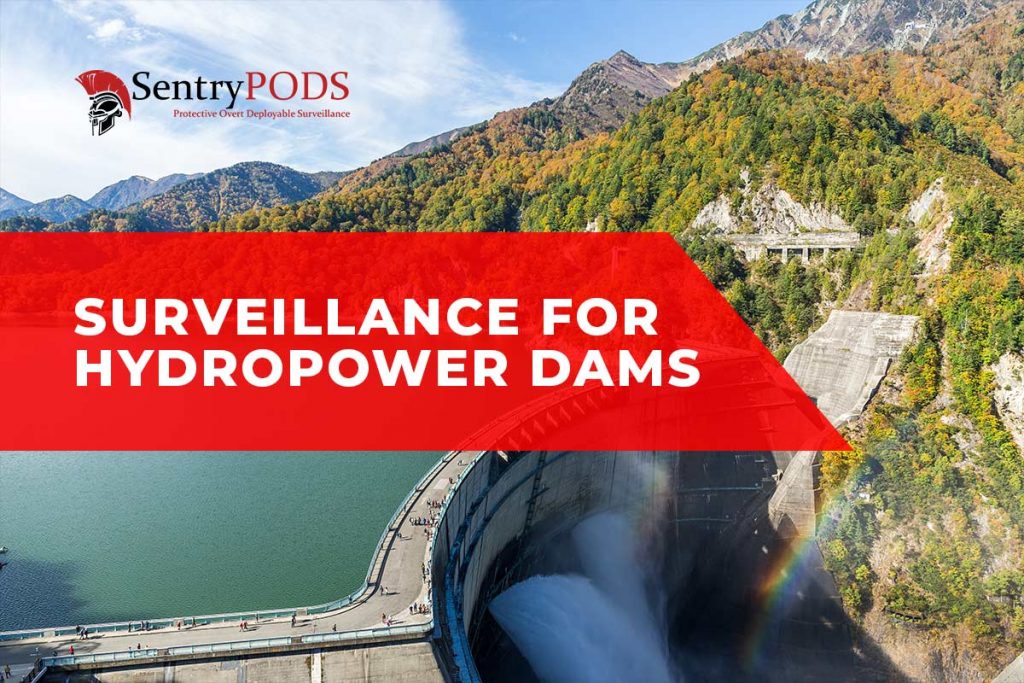Surveillance For Hydropower Dams
 Generating electricity through hydropower is one of the cleanest ways of producing energy. In 2012, it was estimated that hydroelectric plants contributed about 16 percent of the world’s total power generation. Hydropower is the most widely used form of renewable energy, eclipsing the energy generated by both solar and wind farms. The cost to produce energy through hydropower is relatively low, making it a very popular option for green energy proponents. However, like all critical infrastructure, dams and other water sites face security risks that must be addressed. Hydropower surveillance is a growing business and one that is necessary to secure this precious resource. With that being said, the need for critical infrastructure surveillance continues to grow.
Generating electricity through hydropower is one of the cleanest ways of producing energy. In 2012, it was estimated that hydroelectric plants contributed about 16 percent of the world’s total power generation. Hydropower is the most widely used form of renewable energy, eclipsing the energy generated by both solar and wind farms. The cost to produce energy through hydropower is relatively low, making it a very popular option for green energy proponents. However, like all critical infrastructure, dams and other water sites face security risks that must be addressed. Hydropower surveillance is a growing business and one that is necessary to secure this precious resource. With that being said, the need for critical infrastructure surveillance continues to grow.
What Is A Hydropower Plant?
A hydropower plant is more than just a dam. A hydropower plant is where hydroelectric energy is generated by harnessing the kinetic energy of water. It takes more than just a reserve of water to power our nation’s grid and keep the lights on. Conversely, hydropower surveillance must be deployed throughout the entire facility to protect this critical asset. To understand the security needs of a hydropower plant, we must first understand its components and assess its hydropower surveillance needs.
- The dam – the dam is the most important part of a hydroelectric power plant. To be functional, it must be built on a large river that has an abundance of water throughout the year. It also must be built in such a way that it can maximize the potential energy the river can deliver.
- Water reservoir – a reservoir stores water from the dam. It should be located behind the damn, and at a slightly higher elevation to allow water to move downward effortlessly. The position of the reservoir above the river helps increase the overall potential energy of the water and ultimately produces more electricity once it reaches the facility’s power generation unit.
- Control gates – these gates release and control the water from the reservoir. Water from the damn enters the power generation unit through these gates. When the gates are open, water flows naturally downward toward the facility’s turbines.
- Penstock – this long pipe carries the water from the reservoir toward the power generation unit, which is made up of both the turbines and the generator. The amount of power generated by the hydroelectric plant depends on the amount of water that flows through the penstock.
- Water turbines – when the water flowing through the penstock reaches the power generation unit, it flows over the blades of the turbine and into the turbine shaft. The rotational motion of the turbine blades converts the water’s potential and kinetic energy into hydroelectric power.
- Generator – after the water flows from the turbine into the generator, alternating currents in the coils of the generator produce a magnetic field that is converted into electricity by electromagnetic field induction.
Surveillance Options for Hydropower Facilities
Traditionally, hydropower plants and dams are difficult to secure. The facilities are vast and sprawling, and they are difficult to adequately monitor using only on-site security guards. Effective video surveillance and remote monitoring systems for hydropower sites can help mitigate risk factors, however, and act as a preventive measure against bad actors as well as a proactive way to monitor site health and minimize risk to overall operations. Installing advanced video surveillance systems that feature thermal or infrared cameras to monitor that facility 24/7 and that offer remote monitoring and data analytics is an important first step in your hydropower surveillance plan. Many security systems can integrate with existing intrusion detection systems, offering an add-on solution to protect your critical infrastructure.
Remote monitoring options allow facility operators to monitor and react to threats and maintenance issues in real time before a loss or breakdown occurs. Many systems allow you to check your facilities from any device – phone, tablet, or computer – no matter where you are. By using advanced technology and web-based platforms that integrate with existing operating systems, hydropower plant owners can monitor all areas of the facility to make sure operations are proceeding efficiently. It also allows operators to spot issues that need addressing immediately, and to deploy maintenance or repair crews. This minimizes costly downtime to sites that might be caused by theft, vandalism, or operational issues.
Facility operators may also want to consider traditional security measures like perimeter fencing; however, they may want to install surveillance cameras strategically along the fencing or opt for sensors that detect movement and can be linked to an automated alarm system that goes off if the perimeter is approached. Combining these traditional methods of security with advanced technology will help operators improve the hydropower surveillance at their sites.
Benefits of Advanced Technology for Surveillance
While physical barriers or on-site guards may work in some instances, using advanced technology to monitor a hydropower facility only improves on what security measures are already in place. In addition, the benefits of using advanced technology for hydropower surveillance are many:
- Deter crime – only allowing authorized personnel onsite means that theft, vandalism, and any cyberattack initiated by an insider are reduced and controlled. If an incident does occur on-site, however, a video surveillance system will show who was present and help during the following investigation.
- Prevent Unauthorized Access – remote access reduces the threat of unauthorized access at vulnerable points like gates and doors. By placing surveillance cameras in these key locations, they act as a visual deterrent to criminals and provide the data that would allow you to track any unauthorized criminal access that does occur.
- View Sites Remotely – remote viewing access gives you the ability to monitor your site 24/7. This is a powerful tool to prevent crime and monitor employees, but it also allows facility operators the ability to spot a problem with the physical structure of a hydropower plant before a breach in operations takes place. Remote monitoring allows you to track activity, but special features specifically created for dams and water sites ensure the safety of employees and the integrity of the structure.
- Reduce liability – if the dam were to fail, the failure would affect employees as well as the power grid and people and structures downstream from the facility. Regulating access and proactively monitoring the facility can reduce the chances of unwanted intrusions and make sure the facility is operating efficiently and safely.
Video surveillance is a powerful deterrent to criminals who might impact the physical security of a dam through various means, but it is also can be used to monitor the physical health of the site itself. Because hydroelectric power plants store a vast quantity of water, any breach in the infrastructure could have devastating consequences for those in the vicinity. With advanced surveillance and remote monitoring, hydropower surveillance can be used to guarantee the safety of employees, citizens, and the grid even if you are off-site.
Learn more about surveillance options for critical infrastructure in the hydropower sector here.

Brent Canfield
CEO and Creator of SentryPODSBrent Canfield, CEO, and founder of Smart Digital and SentryPODS, founded Smart Digital in 2007 after completing a nine-year active-duty career with the United States Marine Corps. During the 2016 election cycle, he provided executive protection for Dr. Ben Carson. He has also authored articles for Security Info Watch.

